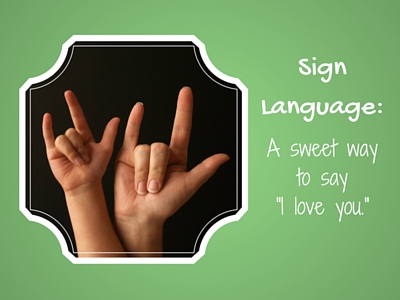 Don’t you wish you could read your baby’s mind?
Don’t you wish you could read your baby’s mind?
You know he wants something, but he can’t tell you. And both of you get frustrated. He starts screaming, and you soon feel like it, too.
“If only he could talk!” you think, trying not to pull out all your hair while his cries get louder.
Maybe it’s time to give your baby a language he can speak without words.
Give him sign language.
Why Learn Sign Language?
Your child’s newly-active hands can help him show you exactly what he wants.
According to the Mayo Clinic, teaching your baby sign language “might help ease frustration between ages 8 months and 2 years — when children begin to know what they want, need and feel but don’t necessarily have the verbal skills to express themselves. Children who have developmental delays might benefit, too.”
A less frustrated baby also makes for a less frustrated parent!
Here’s a sample of a few words babies can learn to say with their hands:
Many parents appreciate how sign language allows their babies to communicate their needs silently. That’s a big plus when you’re in a quiet public setting. For example, your baby can sign that she wants you to breastfeed her without making all heads turn your way.
When to Begin
When your child is about 6-7 months old, he will begin developing hand coordination, a sense of give-and-take in conversation, and the ability to retain mental images. That’s a good time to start introducing sign language. When you see those developments in your child, you know he’s ready to start learning to sign.
Be patient. At first, your child won’t seem to get it. Just keep using those signs. It may take several weeks before you see him start to mimic your signs at appropriate times. But watch his face and you’ll see how excited he is when you can understand him!
How to Start
Start with common, easy signs. You can find these in the video above:
- “more”
- ”eat”
- ”milk” (This works for breast milk, too.)
Watch for teachable moments. These are moments when:
- You have his full attention.
- He wants the thing you are trying to teach: teach the sign for “milk” when he’s thirsty.
- He is receptive to learning – not sleepy or upset.
Repeat signs frequently. Try using them:
- In conversation with your child’s other parent/caregiver and siblings.
- In everyday moments: use the “eat” sign just as you put him in his highchair, for example.
- Each time you mention that word. (You may feel silly, but each repetition brings him closer to learning it.)
Reward his attempts to do the signs.
- Watch for gestures that are similar to the sign.
- Show excitement that he is trying to sign: “That’s right, Timmy, this is ‘milk’! Very good!”
- Give him what he has asked for even if his sign isn’t exactly perfect.
How to Learn More
There is a lot more your baby will need to express than “milk” and “eat” and “more.” You can learn more signs by checking out this Sign Language Dictionary.
Try these apps:
- Baby Sign Language Dictionary (iOS)
- My Smart Hands (iOS)
- ASL Dictionary for Babies (Android)
For more in-depth training on how and why to teach your baby sign language, and to hear from real parents who have tried sign language with their kids, stop in at Choices Pregnancy Center. Ask to watch our DVD, Sign With Your Baby. (Click here to watch a sample.) It’s part of our Earn While You Learn program, which gives you free, practical assistance to support you in becoming the parent you want to be.
———-
Have you used sign language with your child? How did it work for you?
Share your experiences below.

